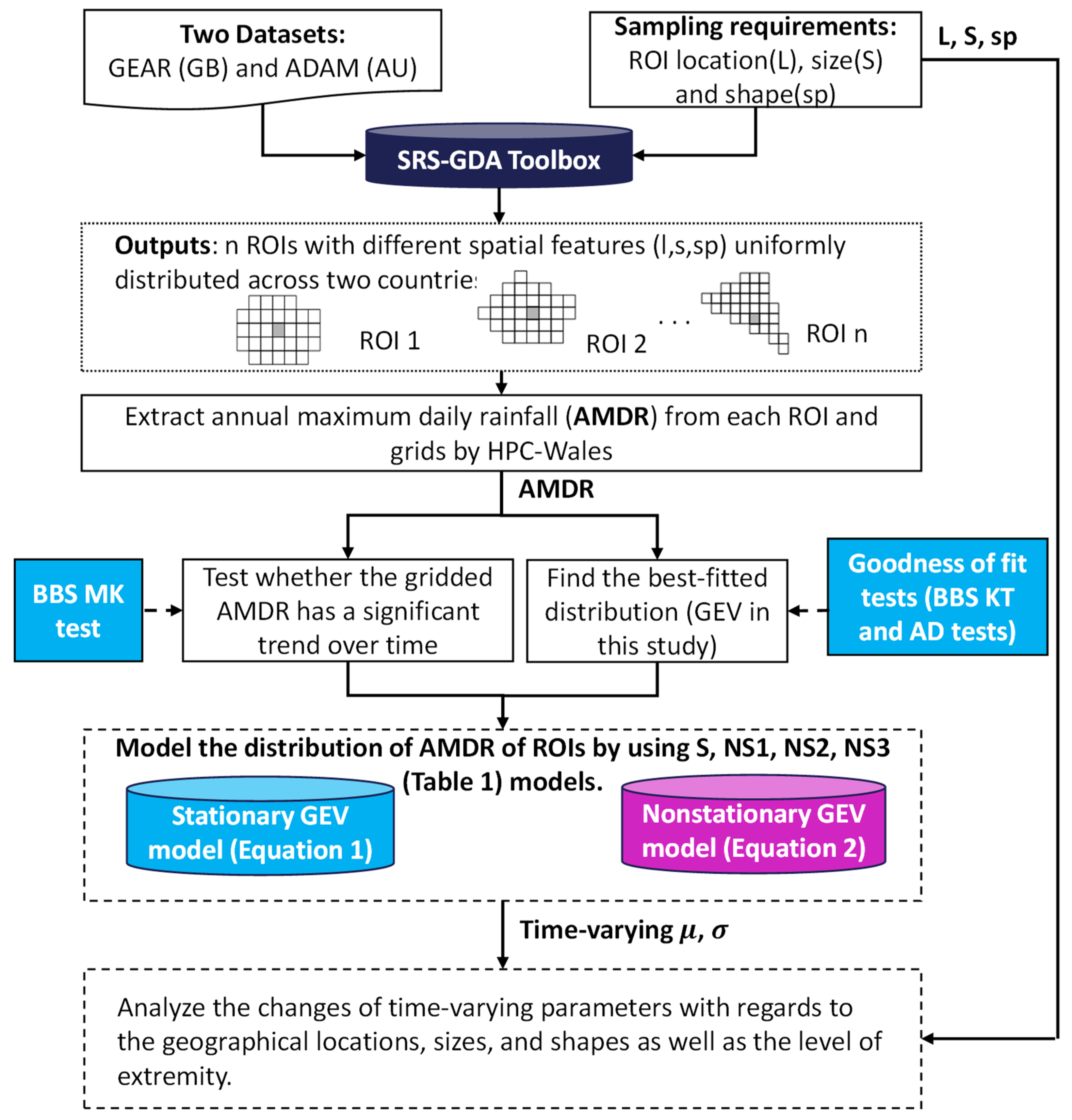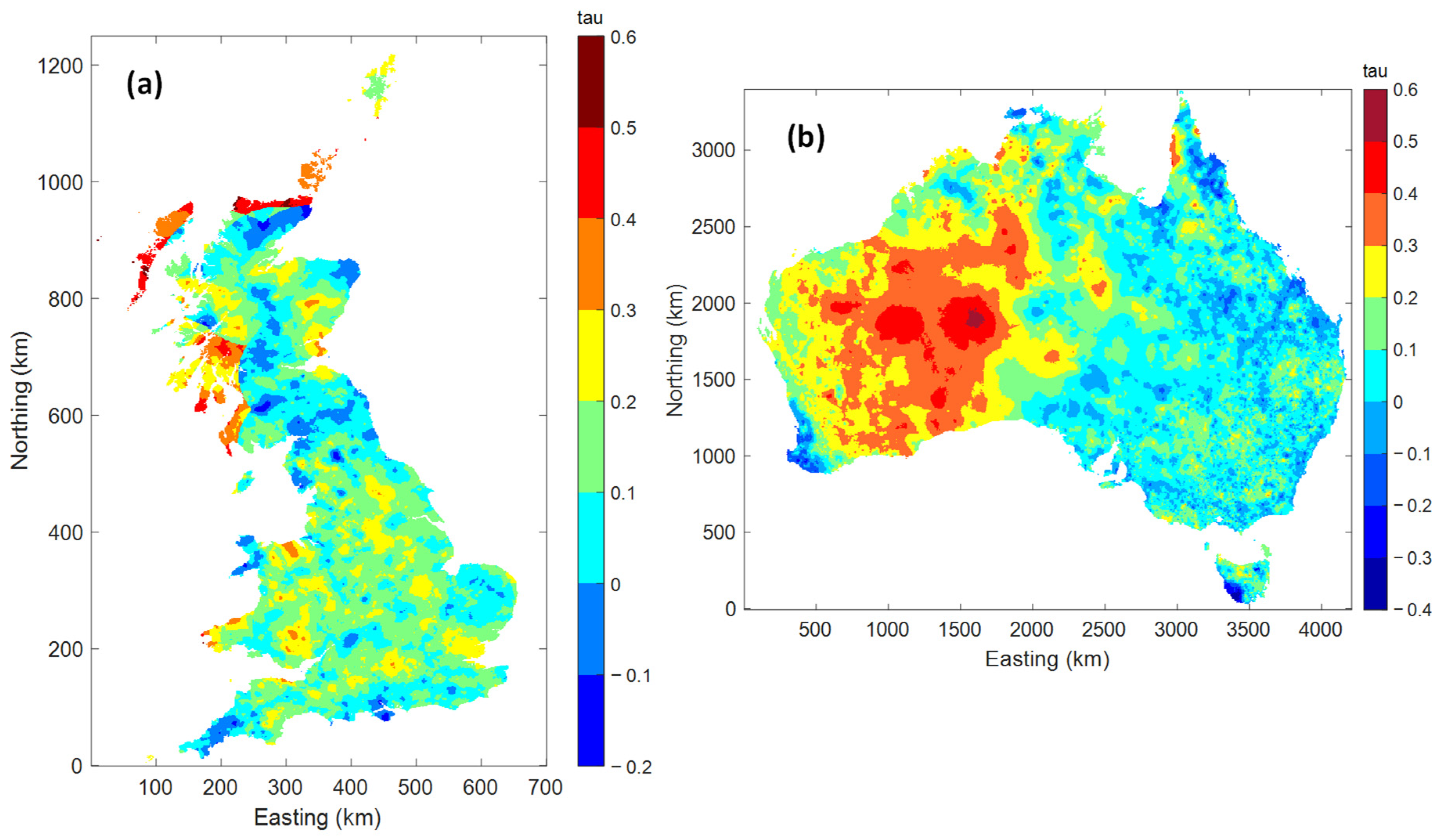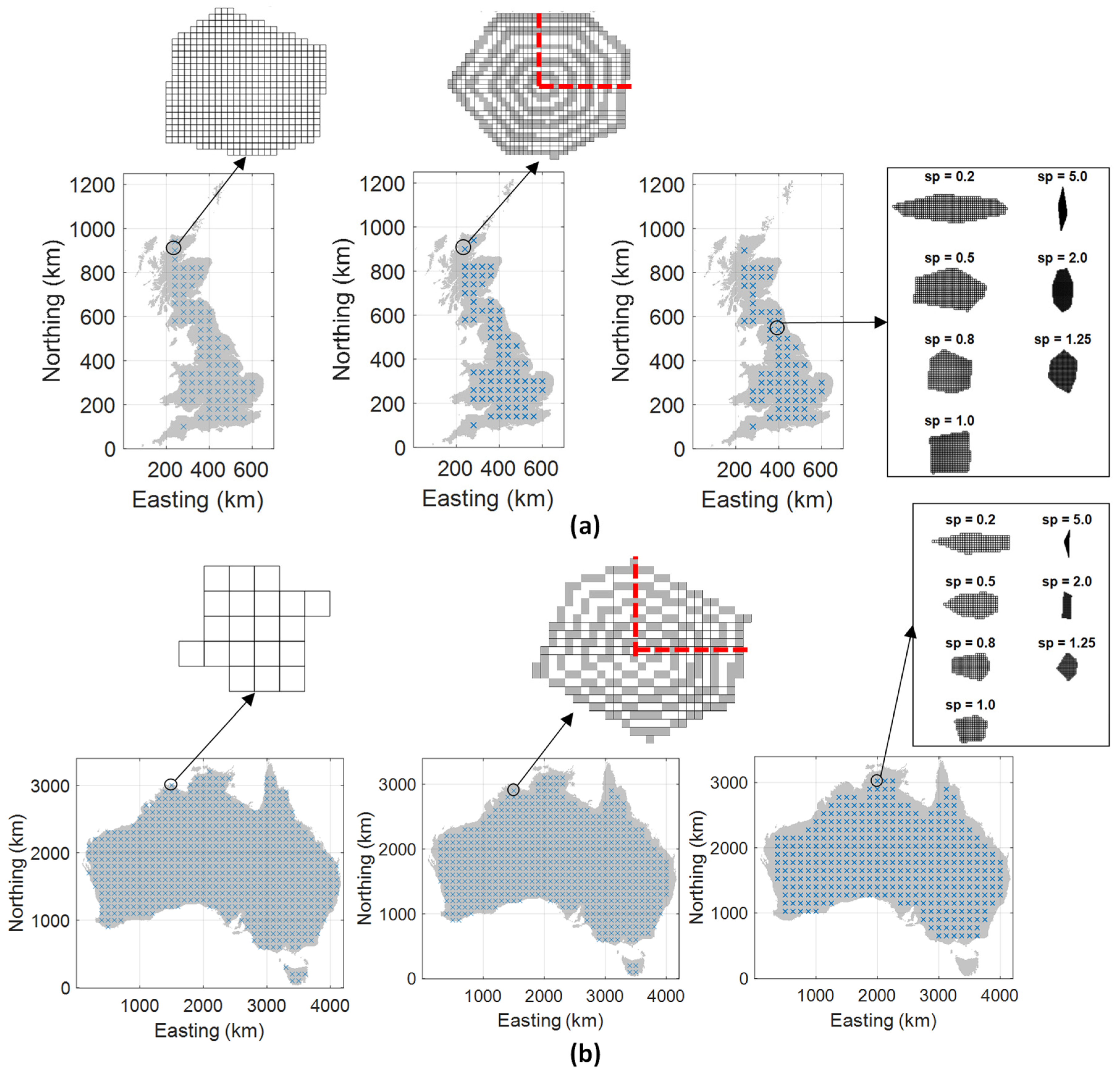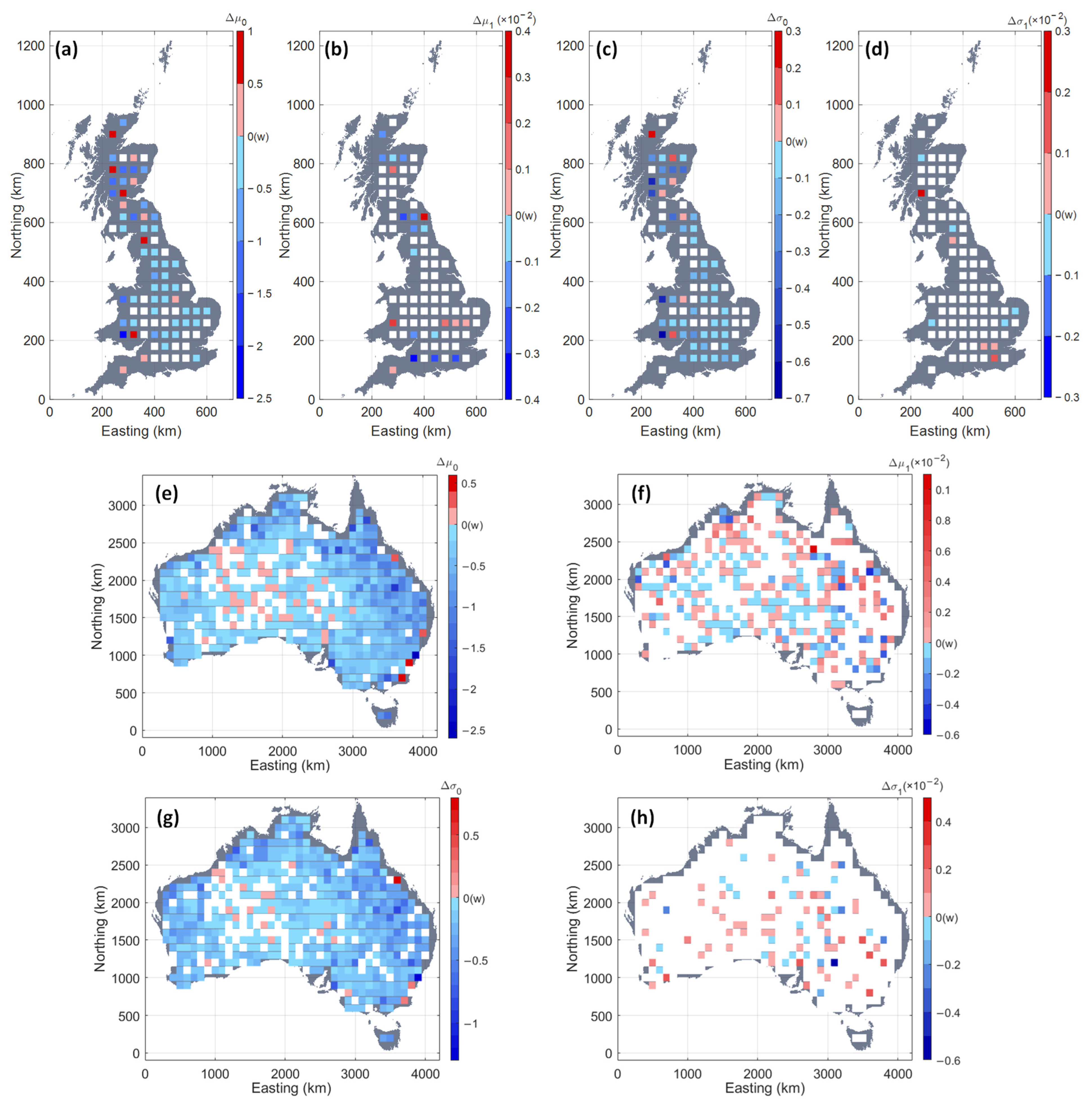An Area-Orientated Analysis of the Temporal Variation of Extreme Daily Rainfall in Great Britain and Australia
Abstract
:1. Introduction
2. Methods
- Generate ROIs with varying locations, sizes and shapes and extract the annual maximum daily rainfall (AMDR) time series with the assistance of high-performance computing (HPC).
- Fit the time series obtained at every ROI with stationary and nonstationary GEV models with different parameter estimation methods.
- Evaluate the performance of all models and analyse the changes of time-varying parameters with regard to the geographical locations, sizes, and shapes as well as the level of extremity.
2.1. Data, ROIs and Extreme Rainfall in Two Countries
2.2. Stationary and Nonstationary Generalised Extreme Value Models and Return Period
3. Results
3.1. Selection of Stationary and Nonstationary Models and Spatial Nonstationary Patterns
3.2. Spatial Variation in Nonstationary Patterns over ROI Size
3.3. Spatial Variation in Nonstationary Patterns over ROI Shape
3.4. Implication of Return Period
4. Conclusions
- (1)
- In general, the majority of the ROIs in both countries favour the nonstationary GEV model (NS-GEV) and most of them prefer the condition that only assumed to be linearly changing with time; most NS-GEV applications show the ML method performs better than the B-MCMC method (60% and 90% in GB and AU). AMDR of over 80% ROIs in both countries follows Fréchet distribution.
- (2)
- Geographic location is the most significant factor that affects not only the average status of the baseline climate (with respect to and ) but also the time-varying changes due to climate change (with respect to and ). During the last century in GB, the changes in the level of the most frequent AMDR (with respect to ) are in the range of and the majority of areas show a non-decreasing trend. However, in AU, the south-middle zone and the eastern coasts are dominated by an increasing up to the rate of +20% while the north coast of Northern Territory and west-south coast of Western Australia are controlled by a decreasing with the rate of . The majority of regions of GB and AU are observed to a still while some specific regions with a decreasing scattering near the coasts of England indicate a decreasing occurrence probability of extremes.
- (3)
- Region size is shown to be a secondary factor. Generally, the two countries show a decreased average status of climate with an increase in size because of the statistical average. However, near the coastal regions of GB and the boundary of the south-middle dry zone of AU, some ROIs have an increasing status. Although the effect of region size on time-varying changes is insignificant, the climate change impact is not always decreased with the increase in region size but is influenced by geographical locations.
- (4)
- Region shape does not significantly affect either the average climate status or time-varying changes; however, a symmetric pattern of average climate status is found for regions with reciprocal spatial indexes and the average climate status in ROIs with a relatively rounded shape is usually higher than the elongated ones
- (5)
- The stationary GEV models underestimate the risk in several specific regions such as the coastal regions in both countries where the nonstationary model is preferred. It may inspire a re-consideration of the current design storm determination procedure.
Supplementary Materials
Author Contributions
Funding
Data Availability Statement
Acknowledgments
Conflicts of Interest
References
- World Meteorological Organization. Climate Data, Guidelines on Analysis of Extremes in a Changing Climate in Support of Informed Decisions for Adaptation; World Meteorological Organization: Geneva, Switzerland, 2009. [Google Scholar]
- Jenkinson, A.F. The frequency distribution of the annual maximum (or minimum) values of meteorological elements. Q. J. R. Meteorol. Soc. 1955, 81, 158–171. [Google Scholar] [CrossRef]
- Coles, S.G.; Tawn, J.A. A Bayesian analysis of extreme rainfall data. J. R. Stat. Soc. Ser. C (Appl. Stat.) 1996, 45, 463–478. [Google Scholar] [CrossRef]
- Lazoglou, G.; Anagnostopoulou, C. An Overview of Statistical Methods for Studying the Extreme Rainfalls in Mediterranean. Proceedings 2017, 1, 681. [Google Scholar]
- Mannshardt-Shamseldin, E.C.; Smith, R.L.; Sain, S.R.; Mearns, L.O.; Cooley, D. Downscaling extremes: A comparison of extreme value distributions in point-source and gridded precipitation data. Ann. Appl. Stat. 2010, 4, 484–502. [Google Scholar] [CrossRef] [Green Version]
- Shukla, R.K.; Trivedi, M.; Kumar, M. On the proficient use of GEV distribution: A case study of subtropical monsoon region in India. arXiv 2012, arXiv:1203.0642. [Google Scholar]
- Yoon, S.; Kumphon, B.; Park, J.-S. Spatial Modelling of Extreme Rainfall in Northeast Thailand. Procedia Environ. Sci. 2015, 26, 45–48. [Google Scholar] [CrossRef] [Green Version]
- Assani, A.; Guerfi, N. Analysis of the Joint Link between Extreme Temperatures, Precipitation and Climate Indices in Winter in the Three Hydroclimate Regions of Southern Quebec. Atmosphere 2017, 8, 75. [Google Scholar] [CrossRef] [Green Version]
- Herring, S.C.; Hoell, A.; Christidis, N.; Stott, P. Explaining extreme events of 2016 from a climate perspective. Bull. Am. Meteorol. Soc. 2018, 99, S1–S157. [Google Scholar] [CrossRef] [Green Version]
- Sarhadi, A.; Burn, D.H.; Ausín, M.C.; Wiper, M.P. Time-Varying nonstationary multivariate risk analysis using a dynamic Bayesian copula. Water Resour. Res. 2016, 52, 2327–2349. [Google Scholar] [CrossRef]
- Son, C.; Lee, T.; Kwon, H.H. Integrating nonstationary behaviors of typhoon and nontyphoon extreme rainfall events in East Asia. Sci. Rep. 2017, 7, 5097. [Google Scholar] [CrossRef] [Green Version]
- Hasan, H.; Radi, N.F.A.; Kassim, S. Modeling of extreme temperature using generalized extreme value (GEV) distribution: A case study of Penang. AIP Conf. Proc. 2012, 1522, 1195. [Google Scholar]
- Sarhadi, A.; Soulis, E.D. Time-Varying extreme rainfall intensity-duration-frequency curves in a changing climate. Geophys. Res. Lett. 2017, 44, 2454–2463. [Google Scholar] [CrossRef]
- Panagoulia, D.; Economou, P.; Caroni, C. Stationary and nonstationary generalized extreme value modelling of extreme precipitation over a mountainous area under climate change. Environmetrics 2014, 25, 29–43. [Google Scholar] [CrossRef]
- Ragulina, G.; Reitan, T. Generalized extreme value shape parameter and its nature for extreme precipitation using long time series and the Bayesian approach. Hydrol. Sci. J. 2017, 62, 863–879. [Google Scholar] [CrossRef] [Green Version]
- King, A.; Klingaman, N.; Alexander, L.; Donat, M.; Jourdain, N.; Maher, P. Extreme rainfall variability in Australia: Patterns, drivers, and predictability. J. Clim. 2014, 27, 6035–6050. [Google Scholar] [CrossRef] [Green Version]
- Ishak, E.; Rahman, A.; Westra, S.; Sharma, A.; Kuczera, G. Evaluating the non-stationarity of Australian annual maximum flood. J. Hydrol. 2013, 494, 134–145. [Google Scholar] [CrossRef]
- Mondal, A.; Mujumdar, P.P. Modeling non-stationarity in intensity, duration and frequency of extreme rainfall over India. J. Hydrol. 2015, 521, 217–231. [Google Scholar] [CrossRef]
- Yilmaz, A.; Imteaz, M.; Perera, B. Investigation of non-stationarity of extreme rainfalls and spatial variability of rainfall intensity–frequency–duration relationships: A case study of Victoria, Australia. Int. J. Climatol. 2017, 37, 430–442. [Google Scholar] [CrossRef]
- Wang, H.; Xuan, Y. Spatial Variation of Extreme Rainfall Observed from Two Century-long Datasets. Geophys. Res. Lett. 2020, 48, e2020GL091933. [Google Scholar] [CrossRef]
- Fischer, E.M.; Knutti, R. Detection of spatially aggregated changes in temperature and precipitation extremes. Geophys. Res. Lett. 2014, 41, 547–554. [Google Scholar] [CrossRef]
- de Leeuw, J.; Methven, J.; Blackburn, M. Variability and trends in England and Wales precipitation. Int. J. Climatol. 2016, 36, 2823–2836. [Google Scholar] [CrossRef] [Green Version]
- Brown, S.J. The drivers of variability in UK extreme rainfall. Int. J. Climatol. 2018, 38, e119–e130. [Google Scholar] [CrossRef] [Green Version]
- Survey, O. A Brief Description of the National Grid and Reference System; His Majesty’s Stationery Office (HMSO): London, UK, 1946. [Google Scholar]
- Tanguy, M.; Dixon, H.; Prosdocimi, I.; Morris, D.G.; Keller, V.D.J. Gridded Estimates of Daily and Monthly Areal Rainfall for the United Kingdom (1890–2015) [CEH-GEAR]; NERC Environmental Information Data Centre (Dataset): Oxford, UK, 2016. [Google Scholar] [CrossRef]
- Collier, P. Development of Australia’s National GDA94 Transformation Grids. Consultant’s Report to the Intergovernmental Committee on Surveying and Mapping; The University of Melbourne: Melbourne, Australia, 2002; Available online: https://icsm-prod.oxide.co/sites/default/files/natgrids_0.pdf (accessed on 27 December 2022).
- Jones, D.A.; Wang, W.; Fawcett, R. High-quality spatial climate data-sets for Australia. Aust. Meteorol. Oceanogr. J. 2009, 58, 233. [Google Scholar] [CrossRef]
- Kundzewicz, Z.W.; Robson, A.J. Change detection in hydrological records—A review of the methodology/revue méthodologique de la détection de changements dans les chroniques hydrologiques. Hydrol. Sci. J. 2004, 49, 7–19. [Google Scholar] [CrossRef]
- Önöz, B.; Bayazit, M. Block bootstrap for Mann–Kendall trend test of serially dependent data. Hydrol. Process. 2012, 26, 3552–3560. [Google Scholar] [CrossRef]
- Sonali, P.; Kumar, D.N. Review of trend detection methods and their application to detect temperature changes in India. J. Hydrol. 2013, 476, 212–227. [Google Scholar] [CrossRef]
- Wang, H.; Xuan, Y. SRS-GDA: A spatial random sampling toolbox for grid-based hydro-climatic data analysis in environmental change studies. Environ. Model. Softw. 2020, 124, 104598. [Google Scholar] [CrossRef]
- Kolmogorov, A. Sulla determinazione empirica di una lgge di distribuzione. Inst. Ital. Attuari Giorn. 1933, 4, 83–91. [Google Scholar]
- Smirnov, N. Table for estimating the goodness of fit of empirical distributions. Ann. Math. Stat. 1948, 19, 279–281. [Google Scholar] [CrossRef]
- Anderson, T.W.; Darling, D.A. Asymptotic theory of certain “goodness of fit” criteria based on stochastic processes. Ann. Math. Stat. 1952, 23, 193–212. [Google Scholar] [CrossRef]
- Anderson, T.W.; Darling, D.A. A test of goodness of fit. J. Am. Stat. Assoc. 1954, 49, 765–769. [Google Scholar] [CrossRef]
- Helton, J.C.; Davis, F.J. Latin hypercube sampling and the propagation of uncertainty in analyses of complex systems. Reliab. Eng. Syst. Saf. 2003, 81, 23–69. [Google Scholar] [CrossRef] [Green Version]
- Sadegh, M.; Ragno, E.; AghaKouchak, A. Multivariate C opula A nalysis Toolbox (MvCAT): Describing dependence and underlying uncertainty using a B ayesian framework. Water Resour. Res. 2017, 53, 5166–5183. [Google Scholar] [CrossRef]
- Binder, K.; Ceperley, D.M. Monte Carlo Methods in Statistical Physics; Springer Science & Business Media: Berlin/Heidelberg, Germany, 2012; Volume 7. [Google Scholar]
- Manly, B.F.J. Randomization, Bootstrap and Monte Carlo Methods in Biology; Chapman and Hall/CRC: Boca Raton, FL, USA, 2018. [Google Scholar]
- Metropolis, N.; Ulam, S. The monte carlo method. J. Am. Stat. Assoc. 1949, 44, 335–341. [Google Scholar] [CrossRef]
- Gelman, A.; Rubin, D.B. Inference from iterative simulation using multiple sequences. Stat. Sci. 1992, 7, 457–472. [Google Scholar] [CrossRef]
- Akaike, H.; Petrov, B.N.; Csaki, F. Second International Symposium on Information Theory; Akadémiai Kiadó: Budapest, Hungary, 1973. [Google Scholar]
- Schwarz, G. Estimating the dimension of a model. Ann. Stat. 1978, 6, 461–464. [Google Scholar] [CrossRef]
- Read, L.K.; Vogel, R.M. Reliability, return periods, and risk under nonstationarity. Water Resour. Res. 2015, 51, 6381–6398. [Google Scholar] [CrossRef]
- Sen, P.K. Estimates of the regression coefficient based on Kendall’s tau. J. Am. Stat. Assoc. 1968, 63, 1379–1389. [Google Scholar] [CrossRef]
- Gilks, W.R.; Best, N.G.; Tan, K. Adaptive rejection Metropolis sampling within Gibbs sampling. J. R. Stat. Soc. Ser. C (Appl. Stat.) 1995, 44, 455–472. [Google Scholar]
- Myung, I.J. Tutorial on maximum likelihood estimation. J. Math. Psychol. 2003, 47, 90–100. [Google Scholar]
- Roberts, G.O.; Rosenthal, J.S. Examples of adaptive MCMC. J. Comput. Graph. Stat. 2009, 18, 349–367. [Google Scholar]
- Ter Braak, C.J. A Markov Chain Monte Carlo version of the genetic algorithm Differential Evolution: Easy Bayesian computing for real parameter spaces. Stat. Comput. 2006, 16, 239–249. [Google Scholar]







| Description | Parameters | Estimation Method(s) |
|---|---|---|
| Stationary model: | are constant | ML 1 |
| Nonstationary model 1: | ML and B-MCMC 2 | |
| Nonstationary model 2: | ML and B-MCMC | |
| Nonstationary model 3: | ML and B-MCMC |
Disclaimer/Publisher’s Note: The statements, opinions and data contained in all publications are solely those of the individual author(s) and contributor(s) and not of MDPI and/or the editor(s). MDPI and/or the editor(s) disclaim responsibility for any injury to people or property resulting from any ideas, methods, instructions or products referred to in the content. |
© 2022 by the authors. Licensee MDPI, Basel, Switzerland. This article is an open access article distributed under the terms and conditions of the Creative Commons Attribution (CC BY) license (https://creativecommons.org/licenses/by/4.0/).
Share and Cite
Wang, H.; Xuan, Y. An Area-Orientated Analysis of the Temporal Variation of Extreme Daily Rainfall in Great Britain and Australia. Water 2023, 15, 128. https://doi.org/10.3390/w15010128
Wang H, Xuan Y. An Area-Orientated Analysis of the Temporal Variation of Extreme Daily Rainfall in Great Britain and Australia. Water. 2023; 15(1):128. https://doi.org/10.3390/w15010128
Chicago/Turabian StyleWang, Han, and Yunqing Xuan. 2023. "An Area-Orientated Analysis of the Temporal Variation of Extreme Daily Rainfall in Great Britain and Australia" Water 15, no. 1: 128. https://doi.org/10.3390/w15010128
APA StyleWang, H., & Xuan, Y. (2023). An Area-Orientated Analysis of the Temporal Variation of Extreme Daily Rainfall in Great Britain and Australia. Water, 15(1), 128. https://doi.org/10.3390/w15010128







